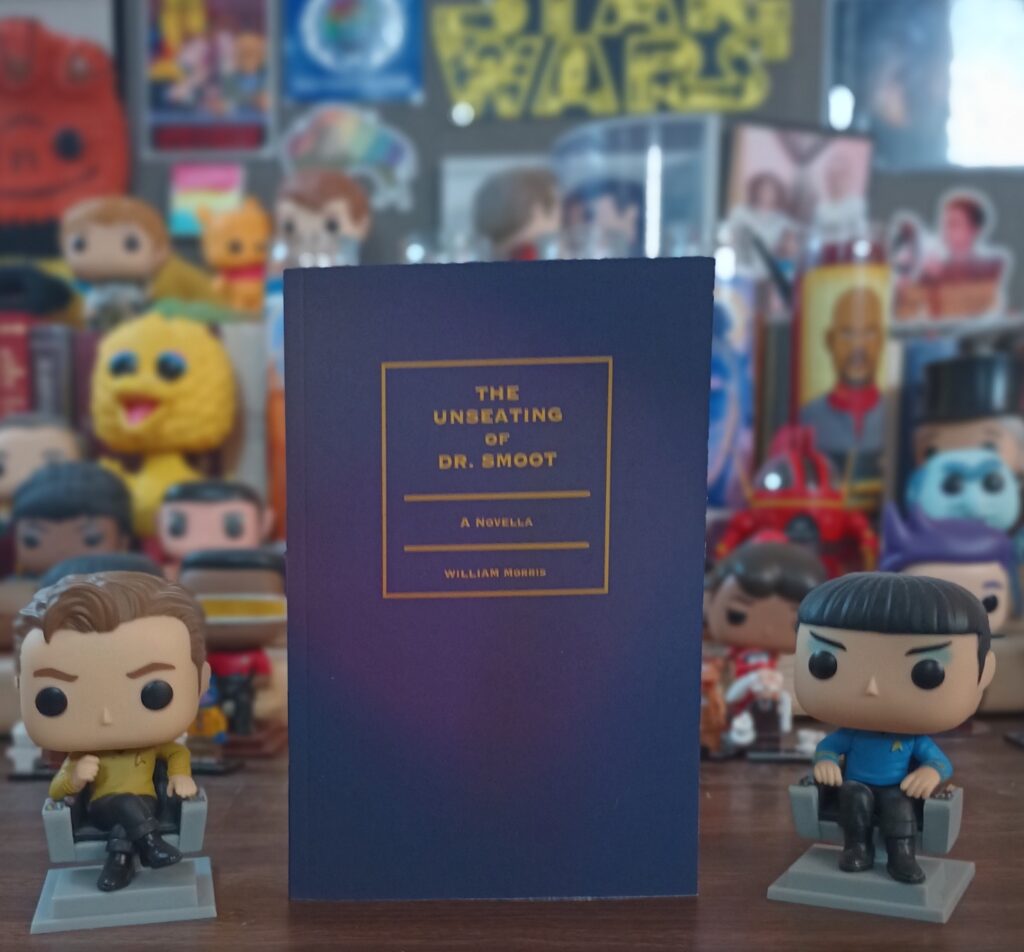Review
———
Title: The Unseating of Dr. Smoot: A Novella
Author: William Morris
Publisher: A Motley Vision
Genre: Fiction
Year Published: 2023
Number of Pages: 124
ISBN-13: 979-8864377192
Format: Paperback , e Book
Price: Print, 11.99; e book, 4.99
Reviewed by Conor Hilton for the Association of Mormon Letters
As a big fan of William Morris’ writing, I’ve eagerly and somewhat anxiously awaited The Unseating of Dr. Smoot: A Novella. I love William’s weird work, so I was unsure how I’d respond to something of his more in a vein of faithful realism. I thoroughly enjoyed and appreciated The Unseating of Dr. Smoot and revisiting the two short stories, “Conference” and “The Ward Organist,” included here as “Precursors.”
The Unseating of Dr. Smoot is a resonant, deliberate, thoughtful work, speaking powerfully to many of my own experiences and feelings as a Ph.D. candidate in English literature, living in the Midwest, often returning to Utah and the Mountain West. The biographic and dispositional overlap between me and the titular Dr. Rebecca Smoot certainly aided in much of this resonance, though I believe that readers with fewer points of connection would also find much to recommend William’s latest offering. This conviction rests in part on the ways that the differences in my experience/life and that of the character of Rebecca enriched my reading experience and created new avenues and possibilities for insight that were engaging and refreshing.
The novella is structured as a typical sacrament meeting; that is, each of the chapters is titled after one of the generic stages of a standard program– “prelude,” “announcements, “administration of the sacrament,” “youth talk,” “special musical number, “adult talk,” etc. It took me until about halfway through the novella to begin to notice some of the small resonances and rhymes that are created through this structure. However, once I did, I was delighted to continue to find the ways that the structure aids and enhances the thematic and narrative work of the text. I suspect there would be even more richness to mine from these connections if they were paid close scrutiny.
One particular example of such resonance is that Rebecca’s talk on Gilead and Marilynne Robinson is the novella’s “Administration of the Sacrament.” The academic talk, open to the public, at Brigham Young University, is the site of communion and spiritual uplift, the main ordinance of the novella. This connection, and others like it, also strikes me as doing character work, building out some of the beliefs and ideas that Rebecca holds. Or perhaps simply giving us a glimpse of the subconscious connections that she makes between her academic career and spiritual life.
A somewhat lengthy excerpt from that section strikes me as vital to understanding Rebecca, some of what the novella is doing within the tradition of Mormon literature, and giving a glimpse of some of William’s own interests and literary projects (if encountered somewhat refracted here through the character of Rebecca):
“Instead I want you–and this extends to any faculty, staff, administrators, and members of the community who are here–to feel haunted by this place, or whatever place you come from. And rather than attempt to run from or hide from those feelings, turn towards them. Embrace them. Embrace the ghosts. Get to know them. Maybe even reckon with them. Let them be present for you just like the people of our day were present for Nephi and so many of the other prophets in the Book of Mormon” (36).
Love this as a call for Mormon scholars and artists to embrace our peculiarity and ‘ghosts’, to reckon with those things from our past in a way that brings the past into the present (and perhaps draws the future into the present as well–a sort of art as prophecy idea). The injunction from Rebecca to her audience to ‘feel haunted by this place’ is particularly striking and resonant within the novella, because as it draws to a close, she remains haunted by Utah, filled with a simultaneous yearning for and relief at leaving.
This sensation is one of the most rich feelings that the novella evokes and is part of its success. I know this feeling well, experientially at least. I spent about a decade living in Provo, attending BYU, and have returned many times since leaving to see family and friends still in the area. Nothing else I’ve read has quite captured the mix of emotions that I feel about Utah, especially Utah Valley, as well as The Unseating of Dr. Smoot.
William Morris has done it again! The Unseating of Dr. Smoot takes a structurally inventive approach to the novella, using the formal constraints and shape to inform the themes and narrative. A quick read with much to ponder, particularly for those in humanistic and academic pursuits that intersect with their own religious tradition. A revealing little book about the mundane complexities of the life of a disciple-scholar, that I will continue to cast my mind back to for quite some time.

